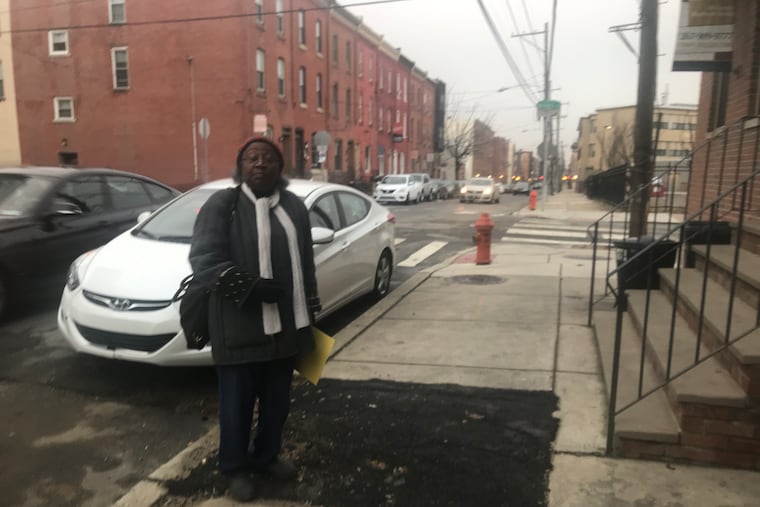Where’s the historical marker for influential Harlem Renaissance figure? Nobody knows.
All that’s left where the marker stood is an ugly scar of black asphalt, speckled with sand and dirt, bumpy and messy, spilling haphazardly outside the demarcation lines of the cool gray cement.

Jessie Redmon Fauset was once described by the poet Langston Hughes as a “midwife” of the Harlem Renaissance, just one of many attributes listed on the blue-and-yellow historical marker outside the home in which she died on 17th Street near Berks Street in North Philadelphia.
Now all that’s left where her marker stood is an ugly scar of black asphalt, speckled with sand and dirt, bumpy and messy, spilling haphazardly outside the demarcation lines of the gray concrete.
The $1,500 marker, installed in 1993 across from George Washington Carver High School for Engineering and Sciences, was removed for cleaning and reinstalled in December 2013. But it seems to have disappeared again before 2014, maybe as part of the demolition and subsequent construction of Temple Villas apartments behind where the marker stood.
But neither the city nor the Pennsylvania Historical and Museum Commission, which authorizes and maintains the historical markers, knows where it is. Howard Pollman, director of external affairs for the commission, didn’t even know the Fauset marker was missing until a reporter called.
City spokesperson Mike Dunn said the Streets Department had no information about the marker.
Karen Galle, coordinator of the marker program, has not been successful in reaching the listed contractor for the demolition.
Jackie Wiggins, a retired Philadelphia teacher who now conducts tours of historical sites, knows the exact date she noticed the marker was missing: July 19, 2018.
“I had come here to do a pre-tour for a church group," Wiggins said, "and I knew the marker was supposed to be here.”
However, it wasn’t until Wiggins alerted Faye Anderson, who calls herself a “citizen-preservationist,” at a Kwanzaa celebration last month that Anderson tweeted in protest. Fauset, she said, had been erased from the landscape.
“It’s about public memory and public spaces,” Anderson said. “This marker tells the public that an African American who made a significant contribution to society either lived or worked here. We cannot be left out of these public spaces. It’s about whose story is told and whose story is preserved.”
Fauset, a novelist, essayist, and associate of W.E.B. Du Bois, was also literary editor of the Crisis, the official magazine Du Bois founded as an organ of the NAACP. Fauset published Hughes’ first poem, “The Negro Speaks of Rivers," in the Crisis.
Fauset, who died in 1961, also helped the careers of other Harlem Renaissance writers, including Countee Cullen, Jean Toomer, Claude McKay, and Georgia Douglas Johnson, according to the Cambridge Companion to the Harlem Renaissance.
There are more than 2,500 approved historical markers in Pennsylvania — about 300 of them in Philadelphia — though many go missing, said Galle. Pollman said the state only learns of markers damaged or missing when someone contacts the commission in Harrisburg.
A demolition permit was issued in 2013 to 1853 N. 17th St. LLC, which is owned by Ahmed Michael Alhadad, who also owns Temple Villas.
A woman who answered the phone for Temple Villas didn’t know what happened to the marker but wondered whether a missing marker that hadn’t been noticed for four years was all that important.
Fauset, who is believed to have been the first black woman to graduate from the Philadelphia High School for Girls and who earned degrees in classical languages from Cornell University and the University of Pennsylvania, was also a novelist and essayist in her own right. She published her first novel, There Is Confusion, in 1924. Her second novel, Plum Bun, was about a mixed-race woman who left Philadelphia to be an artist in New York and live as a white woman. Most of her work dealt with the lives of middle-class blacks and topics such as colorism, class divides, and passing.
Fauset herself had a large blended family. After her mother died, her father remarried a woman who had three children of her own. Fauset’s father and stepmother had three more children, to make a total of 13, with Fauset the seventh sibling. According to the original application submitted for the marker, the North Philadelphia home in which Fauset went to live after her husband died in 1958 belonged to her half-brother.
Wiggins, who now lives at 20th and Diamond Streets, remains outraged. Her initial thought — that the marker was being cleaned or repaired — seems far-fetched: The pole was also torn out.
“It was a total disrespect and disregard for the history and culture of a black community," Wiggins said, "that is now being diminished because of gentrification.”
Wiggins, who grew up in what had been the Raymond Rosen Homes at 23rd Street and Diamond in the 1960s, said she remembers looking out a window and telling her mother: “Mama, we must be rich,” to see such beauty.
“It has always been rough and tumble,” Wiggins said. But she said the community also had its teachers and postal workers, doctors and lawyers.
“People assume that we’re not a community, but we have always been a neighborhood of families and people. And when we select someone who has distinguished themselves and has been given the honor of a historic marker, it’s just total indifference to who we are.”